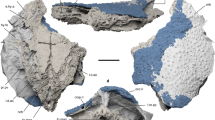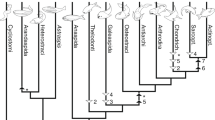Abstract
In some Ophidiiform fishes, the anterior part of the swimbladder is thickened into a hard structure called the “rocker bone”, which is thought to play a role in sound production. Although this structure has been described as cartilage or bone, its nature is still unknown. We have made a thorough analysis of the rocker bone in Ophidion barbatum and compared it with both classical bone and cartilage. The rocker bone appears to be a new example of mineralisation. It consists of (1) a ground substance mainly composed of proteoglycans (mucopolysaccharide acid) and fibres and (2) a matrix containing small mineralised spherules composed of a bioapatite and fibrils. These spherules are embedded in mineralised cement of a similar composition to the spherules themselves. The rocker bone grows via the apposition of new apatite spherules at its periphery. These spherules are first secreted by the innermost fibroblast layer of the capsule contained in the rocker bone and then grow extracellularly. Blood vessels, which represent the only means of transport for matrix and mineral material, are numerous. They enter the rocker bone via the hyle and ramify towards the capsule. We propose to call this new kind of mineralised tissue constituting the rocker bone “frigolite” (the Belgian name for styrofoam) in reference to the presence of spherules of different sizes and the peculiarity of the rocker bone in presenting a smooth surface when fractured.









Similar content being viewed by others
References
Benjamin M (1990) The cranial cartilages of teleosts and their classification. J Anat 169:153–172
Benjamin M, Archer CW, Ralphs JR (1994) Cytoskeleton of cartilage cells. Microsc Res Tech 28:372–377
Beresford WA (1981) Chondroid bone, secondary cartilage and metaplasia. Urban and Schwarzenberg, Baltimore
Beresford WA (1993) Cranial skeletal tissue: diversity and evolutionary trends. In: Hanken J, Hall BK (eds) The skull vol 2. University of Chicago Press, Chicago, pp 69–130
Cole AG, Hall BK (2004a) Cartilage is a metazoan tissue; integrating data from nonvertebrate sources. Acta Zool 85:69–80
Cole AG, Hall BK (2004b) The nature and significance of invertebrate cartilages revisited: distribution and histology of cartilage and cartilage-like tissues within the Metazoa. Zoology 107:261–274
Dalconi MC, Meneghini C, Nuzzo S, Wenk R, Mobilio S (2003) Structure of bioapatite in human foetal bones: an X-ray diffraction study. Nucl Inst Met B 200:406–410
Elliott JC (1994) Structure and chemistry of the apatites and other calcium orthophosphates. Studies in inorganic chemistry, vol 18. Elsevier Science, Amsterdam
Gabe M (1968) Techniques histologiques. Masson et Cie, Paris
Gartner LP, Hiatt JL (1997) Atlas en couleur d'histologie. Pradel, Paris
Howes GJ (1992) Notes on the anatomy and classification of Ophidiiform fishes with particular references to the abyssal genus Acanthonus Günther, 1878. Bull Br Mus Nat Hist Zool 58:95–131
Hughes JM, Cameron M, Crowley KD (1989) Structural variations in natural F, OH, and Cl apatites. Am Miner 74:870–876
Huysseune A (1986) Late skeletal development at the articulation between upper pharyngeal jaws and neurocranial base in the fish, Astatotilapia elegans, with the participation of a chondroid form of bone. Am J Anat 177:119–137
Huysseune A, Sire JY (1990) Ultrastructural observations on chondroid bone in the teleost fish Hemichromis bimaculatus. Tissue Cell 22:371–383
Huysseune A, Sire JY (1992) Development of cartilage and bone tissues of the anterior part of the mandible in cichlid fish: a light and TEM study. Anat Rec 233:357–375
Huysseune A, Verraes W (1986) Chondroid bone on the upper pharyngeal jaws and neurocranial base in tha adult fish Astatotilapia elegans. Am J Anat 177:527–535
Legeros RZ (1985) Preparation of octacalcium phosphate (OCP): a direct fast method. Calcif Tissue Int 37:194–197
Locardi B, Pazzaglia UE, Gabbi C, Profilo B (1993) Thermal behaviour of hydroxyapatite intended for medical applications. Biomaterials 14:437–441
Matallanas J (1980) Etude de l'alimentation d'Ophidion barbatum (Pisces, Ophidiidae) dans la mer catalane. Cybium 1980:81–89
Meunier FJ (1989) The acellularization process in osteichthyan bone. In: Splechtna H, Hilgers H (eds) Trends in vertebrate morphology. Fischer, Stuttgart, pp 443–446
Meunier FJ, François Y (1992) Croissance du squelette chez les Téléostéens. I. Squelette, os, tissus squelettiques. Ann Biol 31:169–184
Meunier FJ, Huysseune A (1992) The concept of bone tissue in Osteichthyes. Neth J Zool 42:445–458
Mortier A, Lemaitre J, Rodrique L, Rouxhet PG (1989) Synthesis and thermal behaviour of well-crystallized calcium-deficient phosphate apatite. J Solid State Chem 78:215–219
Moss ML (1961) Studies of the acellular bone of teleost fish. Acta Anat 46:343–462
Moss ML (1963) The biology of acellular teleost bone. Ann N Y Acad Sci 109:227–350
Parmentier E, Diogo R (2006) Evolutionary trends of swimbladder sound mechanisms in some teleost fishes. In: Ladich F, Collin SP, Moller P, Kapoor BG (eds) Fish communication. Science, USA, pp 43–68
Parmentier E, Chardon M, Vandewalle P (2002) Preliminary study on the ecomorphological signification of the sound-producing complex in Carapidae. In: Aerts PD, Août K, Herrel A, Van Damme R (eds) Topics in functional and ecological vertebrate morphology. Shaker, Maastricht, pp 139–151
Parmentier E, Gennotte V, Focant B, Goffinet G, Vandewalle P (2003a) Characterization of the primary sonic muscles in Carapus acus (Carapidae): a multidisciplinary approach. Proc R Soc Lond [Biol] 270:2301–2308
Parmentier E, Vandewalle P, Lagardère JP (2003b) Sound-producing mechanisms and recordings in Carapini species (Teleostei, Pisces). J Comp Physiol [A] 189:283–292
Parmentier E, Fontenelle N, Fine ML, Vandewalle P, Henrist C (2006) Functional morphology of the sonic apparatus in Ophidion barbatum (Teleostei, Ophidiidae). J Morphol 267:1461–1648
Penel G, Delfosse C, Descamps M, Leroy G (2005) Composition of bone and apatitic biomaterials as revealed by intravital Raman microspectroscopy. Bone 36:893–901
Posner AS, Perloff A, Diorio AF (1958) Refinement of the hydroxyapatite structure. Acta Cryst 11:308–309
Rose JA (1961) Anatomy and sexual dimorphism of the swim bladder and vertebral column in Ophidion holbrooki (Pisces: Ophidiidae). Bull Mar Sci Gulf Carib 11:280–307
Skinner HCW (2000) Minerals and human health. In: Vaughan DJ, Wogelius RA (eds) Environmental mineralogy, European union of mineralogy. Eotvos University Press, Budapest, pp 383–412
Stevens A, Lowe J (1997) Histologie humaine. DeBoeck & Larcier, Bruxelles
Toppets V, Pastoret V, De Behr V, Antoine N, Dessy C, Gabriel A (2004) Morphologie, croissance et remaniement du tissu osseux. Ann Med Vet 148:1–13
Victoria EC, Gnanam FD (2002) Synthesis and characterisation of biphasic calcium phosphate. Trends Biomater Artif Organs 16:12–14
Weiner S, Wagner HD (1998) The material bone: structure-mechanical function relations. Annu Rev Mater Sci 28:271–298
Wopenka B, Pasteris JD (2005) A mineralogical perspective on the apatite in bones. Mater Sci Eng 25:131–143
Zhengwen Y, Yinshan J, Li xin Y, Bo W, Fangfei L, Shemmei S, Tianyi H (2005) Preparation and characterization of magnesium doped hydroxyapatite-gelatin nanocomposite. J Mater Chem 15:1807–1811
Zhou J, Zhang X, Chen J, Zeng S, De Groot K (1993) High temperature characteristics of synthetic hydroxyapatite. J Mater Sci Mater Med 4:83–85
Acknowledgments
The authors thank N. Decloux for her technical assistance with the histology and electron microscopy.
Author information
Authors and Affiliations
Corresponding author
Additional information
E.P. is a Research Associate of the Belgian National Fund for Scientific Research (FRS-FNRS). This study was supported by grant no. 2.4574.01 from the Fonds National de la Recherche Scientifique, Belgium.
Rights and permissions
About this article
Cite this article
Parmentier, E., Compère, P., Casadevall, M. et al. The rocker bone: a new kind of mineralised tissue?. Cell Tissue Res 334, 67–79 (2008). https://doi.org/10.1007/s00441-008-0665-x
Received:
Accepted:
Published:
Issue Date:
DOI: https://doi.org/10.1007/s00441-008-0665-x




